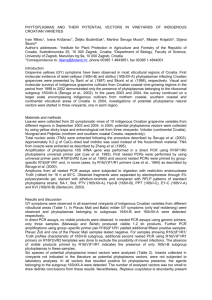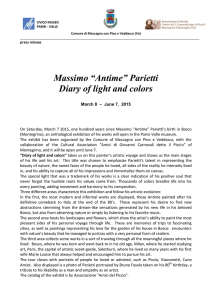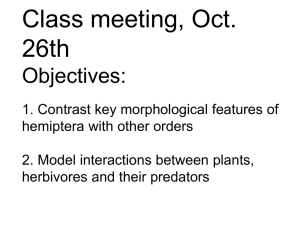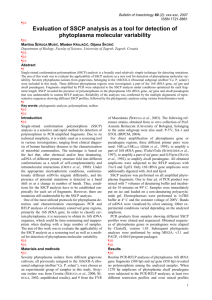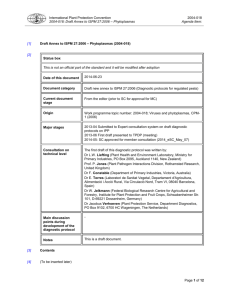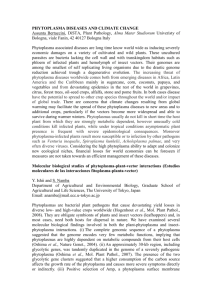research group on insect vectors of plant pathogen
advertisement
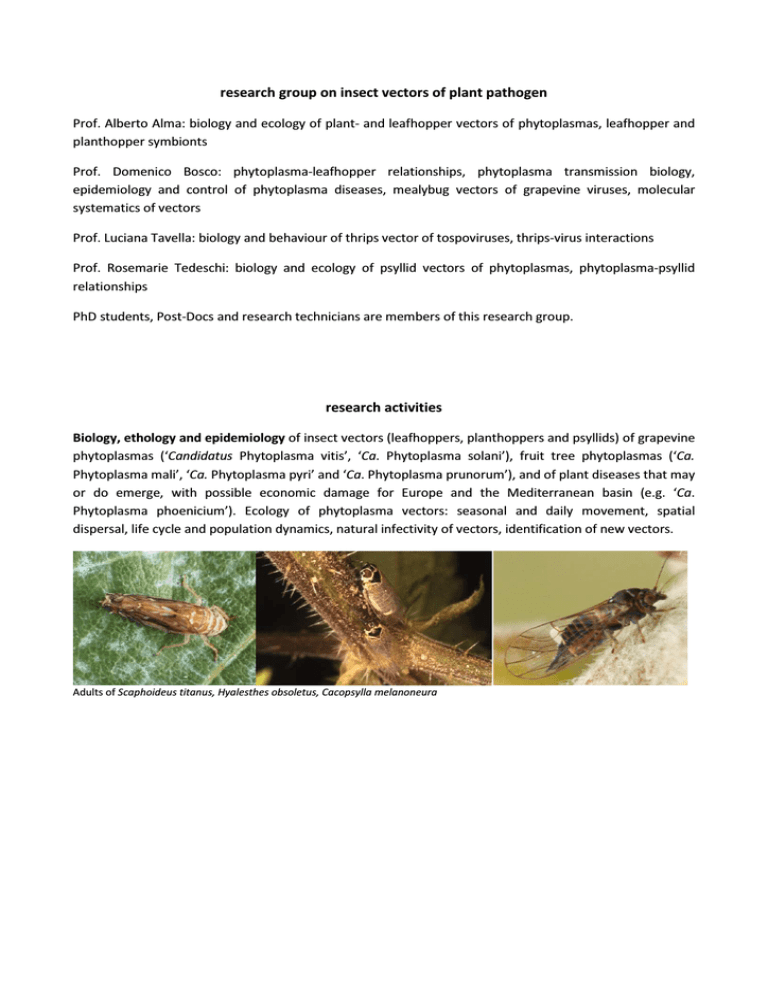
research group on insect vectors of plant pathogen Prof. Alberto Alma: biology and ecology of plant- and leafhopper vectors of phytoplasmas, leafhopper and planthopper symbionts Prof. Domenico Bosco: phytoplasma-leafhopper relationships, phytoplasma transmission biology, epidemiology and control of phytoplasma diseases, mealybug vectors of grapevine viruses, molecular systematics of vectors Prof. Luciana Tavella: biology and behaviour of thrips vector of tospoviruses, thrips-virus interactions Prof. Rosemarie Tedeschi: biology and ecology of psyllid vectors of phytoplasmas, phytoplasma-psyllid relationships PhD students, Post-Docs and research technicians are members of this research group. research activities Biology, ethology and epidemiology of insect vectors (leafhoppers, planthoppers and psyllids) of grapevine phytoplasmas (‘Candidatus Phytoplasma vitis’, ‘Ca. Phytoplasma solani’), fruit tree phytoplasmas (‘Ca. Phytoplasma mali’, ‘Ca. Phytoplasma pyri’ and ‘Ca. Phytoplasma prunorum’), and of plant diseases that may or do emerge, with possible economic damage for Europe and the Mediterranean basin (e.g. ‘Ca. Phytoplasma phoenicium’). Ecology of phytoplasma vectors: seasonal and daily movement, spatial dispersal, life cycle and population dynamics, natural infectivity of vectors, identification of new vectors. Adults of Scaphoideus titanus, Hyalesthes obsoletus, Cacopsylla melanoneura Phytoplasma-vector relationships: phytoplasma fate and multiplication in leafhoppers and psyllids, gene expression in healthy and phytoplasma-infected leafhoppers, molecular determinants of phytoplasma transmission specificity (in vitro and in vivo interactions of the phytoplasma membrane proteins Amp and Imp and insect proteins). A B C A Microinjection of CYAmp fusion protein into the hemocoel of the CY vector Euscelidius variegatus – B and C–sections of Macrosteles quadripunctulatus midgut showing localization of ATP-synthase, a putative receptor of phytoplasmas, on the cell membrane (B, non permeabilized) and inside the cells (C- permeabilized). Vector symbionts. Investigation of interactions occurring between insect vectors of plant pathogens and microbial symbionts residing in their body. Studies have been carried out and are ongoing concerning: i) the composition of insect microbial communities; ii) the role of symbionts in insects; iii) the insect response to symbiont infection; iv) the interaction between symbionts and pathogen transmission. A B C A Fluorescence in situ hybridization (FISH) showing phytoplasmas (green) in salivary glands of Hyalesthes obsoletus - B FISH of H. obsoletus midgut showing the symbiont Sulcia (blue) and other Bacteroidetes (green) (Gonella et al., 2011 Appl Env Microbiol 77(4), 1423-1435)- C FISH showing the symbiont Asaia (yellow) covering the eggs of Scaphoideus titanus for vertical transmission (Crotti et al., 2009 Appl Env Microbiol 11(12), 3252-3264). Thrips-tospovirus relationships. Studies on the system thrips-tospovirus, and in particular Frankliniella occidentalis-Tomato spotted wilt virus (TSWV) to asses: i) relationships between thrips spread and tospovirus diffusion in crops of north-western Italy to implement an integrated pest and disease management; ii) vector ability in transmitting different viral isolates in laboratory leaf disk assays, and detection of virus in thrips by molecular analysis; iii) identification of new tospovirus vector thrips; iv) development of gene silencing in thrips by Virus Induced Gene Silencing (VIGS) technology to evaluate the possible effects on interactions F. occidentalis-TSWV. Adults of Frankliniella occidentalis, symptoms of TSWV on pepper and tomato and transmission laboratory trials by leaf disk assay Mealybug vectors of grapevine viruses (Ampeloviruses, Grapevine Leaf Roll associated viruses 1 and 3, and Vitiviruses, Grapevine Virus A): characterization of virus transmission and virus-vector relationships for the associations between Planococcus ficus/Pl. citri/Heliococcus bohemicus and GLRaV1/GLRaV3/GVA. A B A -Heliococcus bohemicus - B- Planococcus ficus Development of molecular markers for the identification of vector species, biotypes and haplotypes. Recent Publications Lessio F., Tota F., Alma A., in press. Tracking the dispersion of Scaphoideus titanus Ball (Hemiptera: Cicadellidae) from wild to cultivated grapevine: use of a novel mark-capture technique. Bulletin of Entomological Research. 2013 Bertin S., Bosco D., 2013. Molecular identification of phytoplasma vector species. In “Phytoplasma. Methods and Protocols” (M. Dickinson and J. Hodgetts Eds). Springer Protocols, Methods in Molecular Biology 938, Humana Press, New York, pp. 87-108. Bosco D., Mori N., 2013. Flavescence dorée vector control in Italy. Phytopathogenic Mollicutes 3(1): 40-43. Bosco D., Tedeschi R., 2013. Insect vector transmission assays. In “Phytoplasma. Methods and Protocols” (M. Dickinson and J. Hodgetts Eds). Springer Protocols, Methods in Molecular Biology 938, Humana Press, New York, pp.73-85. Galetto L., Bosco D. and Marzachì C. 2013. Selection of reference genes from two leafhopper species challenged by phytoplasma infection, for gene expression studies by RT-qPCR. BMC Research Notes 2013 6: 409 (10 pp) doi:10.1186/1756-0500-6-409. Maggi F., Marzachì C., Bosco D., 2013. A stage-structured model of Scaphoideus titanus in vineyards. Environmental Entomology 42(2): 181-193. DOI: http://dx.doi.org/10.1603/EN12216. Mautino G.C., Bosco L., Tavella L., 2013. Impact of control strategies on Thrips tabaci and its predator Aeolothrips intermedius on onion crops. Phytoparasitica. DOI: 10.1007/s12600-013-0335-8 Monti M., Martini M., Tedeschi R. 2013. EvaGreen Real-time PCR protocol for specific 'Candidatus Phytoplasma mali' detection and quantification in insects. Molecular and Cellular Probes 27 (3-4): 129-136. Vitali M., Chitarra V., Galetto L., Bosco D., Marzachì C., Gullino M.L., Spanna F., Lovisolo C., 2013. Flavescence dorée phytoplasma deregulates stomatal control of photosynthesis in Vitis vinifera. Annals of Applied Biology 162: 335–346. 2012 Camerota C., Raddadi N., Pizzinat A., Gonella E., Crotti E., Tedeschi R., Mozes-Daube N., Ember I., Acs, Z., Kolber M., Zchori-Fein E., Daffonchio D., Alma A. 2012. Incidence of 'Candidatus Liberibacter europaeus' and phytoplasmas in Cacopsylla species (Hemiptera: Psyllidae) and their host/shelter plants. Phytoparasitica 40 (3): 213-221. Crotti E., Balloi A., Hamdi C., Sansonno L., Marzorati M., Gonella E., Favia G., Cherif A., Bandi C., Alma A., Daffonchio D. 2012. Microbial symbionts: a resource for the management of insect-related problems. Minireview. Microbial Biotechnology 5: 307-317. Gonella E., Crotti E., Rizzi A., Mandrioli M., Favia G., Daffonchio D., Alma A. 2012. Horizontal transmission of the symbiotic bacterium Asaia sp. in the leafhopper Scaphoideus titanus Ball (Hemiptera: Cicadellidae). BMC Microbiology 12 (Suppl 1), S4. Mautino G.C., Bosco L., Tavella L., 2012. lntegrated management of Thrips tabaci (Thysanoptera: Thripidae) on onion in north-western ltaly: basic approaches for supervised control. Pest Management Science 68: 185-193. Mautino G.C., Sacco D., Ciuffo M., Turina M., Tavella L., 2012. Preliminary evidence of recovery from Tomato spotted wilt virus infection in Frankliniella occidentalis individuals. Annals of Applied Biology 161: 266-276. Palomera V., Bertin S., Rodrìguez A., Bosco D., Virla E., Moya-Raygoza G., 2012. Is there any genetic variation among native Mexican and Argentinian populations of Dalbulus maidis (Hemiptera: Cicadellidae)? Florida Entomologist, 95(1):150-155. Tedeschi R., Baldessari M., Mazzoni V., Trona F., Angeli G. 2012. Population dynamics of Cacopsylla melanoneura (Hemiptera: Psyllidae) in northeast Italy and its role in the apple proliferation epidemiology in apple orchards. Journal of Economic Entomology 105 (2): 322-328. Turina M., Tavella L., Ciuffo M., 2012. Tospoviruses in the Mediterranean Area. Advances in Virus Research 84: 403-437. 2011 Crotti E., Gonella E., Ricci I., Clementi E., Mandrioli M., Sacchi L., Favia G., Alma A., Bourtzis K., Cherif A., Bandi C., Daffonchio D. 2011. Secondary symbionts of insects: acetic acid bacteria. In “Manipolative tennants: bacteria associated with arthropods”. (E. Zcori-Fein and K. Bourtzis eds.) CRC Press Taylor & Francis Group, Boca Raton, 45-72. Galetto L., Bosco D., Balestrini R., Genre A., Fletcher J., Marzachì C., 2011. The Major Antigenic Membrane Protein of ‘‘Candidatus Phytoplasma asteris’’ Selectively Interacts with ATP Synthase and Actin of Leafhopper Vectors. PLoS ONE, 6(7), e22571. Galetto L., Marzachì C., Demichelis S, Bosco D., 2011. Host plant determines the phytoplasma transmission competence of Empoasca decipiens (Hemiptera: Cicadellidae). Journal of Economic Entomology 104(2): 360-366. Gonella E., Negri I., Marzorati M., Mandrioli M., Sacchi L., Pajoro M., Crotti E., Rizzi A., Clementi E., Tedeschi R., Bandi C., Alma A., Daffonchio D. 2011. Bacterial endosymbiont localization in Hyalesthes obsoletus, the insect vector of Bois Noir in Vitis vinifera. Applied and Environmental Microbiology 77(4): 1423-1435. Lessio F., Mondino E. B., Alma A., 2011. Spatial patterns of Scaphoideus titanus (Hemiptera: Cicadellidae): a geostatistical and neural network approach. International Journal of Pest Management 57 (3): 205-216. Raddadi N., Gonella E., Camerota C., Pizzinat A., Tedeschi R., Crotti E., Mandrioli M., Bianco P.A., Daffonchio D., Alma A. 2011. ‘Candidatus Liberibacter europaeus’ sp. nov. that is associated with and transmitted by the psyllid Cacopsylla pyri apparently behaves as an endophyte rather than a pathogen. Environmental Microbiology 13(2): 414-426. Tsai C.W., Bosco D., Daane K.M., Almeida R.P.P., 2011. Effect of Host Plant Tissue on the Vector Transmission of Grapevine leafroll-associated virus 3. Journal of Economic Entomology 104(5): 1480-1485. 2010 Alma A., Daffonchio D., Gonella E., Raddadi N., 2010. Microbial Symbionts of Auchenorrhyncha transmitting phytoplasmas: a resource for symbiotic control of phytoplasmoses. In “Phytoplasmas: Genomes, Plant Hosts and Vectors” (P. Weintraub and P. Jones Eds). CAB International, Wallingford, UK, pp. 272-292. Bertin S., Picciau L., Acs Z., Alma A., Bosco D., 2010. Molecular identification of the Hyalesthes species (Hemiptera: Cixiidae) occurring in vineyard agroecosystems. Annals of Applied Biology 157: 435–445. Bertin S., Cavalieri V., Graziano C., Bosco D., 2010. Survey of mealybug (Hemiptera: Pseudococcidae) vectors of Ampelovirus and Vitivirus in vineyards of northwestern Italy. Phytoparasitica 38: 401-409. Bertin S., Picciau L., Acs Z., Alma A., Bosco D., 2010. Molecular differentiation of four Reptalus species (Hemiptera: Cixiidae). Bulletin of Entomological Research 100: 551-558. Bosco D., D’Amelio R., 2010. Transmission specificity and competition of multiple phytoplasmas in the insect vector. In “Phytoplasmas: Genomes, Plant Hosts and Vectors” (P. Weintraub and P. Jones Eds). CAB International, Wallingford, UK, pp. 293-308. Bosco L., Tavella L., 2010. Population dynamics and integrated pest management of Thrips tabaci on leek under field conditions in northwest Italy. Entomologia Experimentalis et Applicata 135: 276-287. Ciuffo M., Mautino G.C., Bosco L., Turina M., Tavella L., 2010. Identification of Dictyothrips betae as the vector of Polygonum ring spot virus. Annals of Applied Biology 157: 299-307. Crotti E., Rizzi A., Chouaia B., Ricci I., Favia G., Alma A., Sacchi L., Bourtzis K., Mandrioli M., Cherif A., Bandi C., Daffonchio D., 2010. Acetic Acid Bacteria, Newly Emerging Symbionts of Insects. MINIREVIEW. Applied and Environmental Microbiology 76 (21): 6963-6970. Tedeschi R., Nardi F., 2010. DNA-based discrimination and frequency of phytoplasma infection in the two hawthorn-feeding species, Cacopsylla melanoneura and Cacopsylla affinis, in northwestern Italy. Bulletin of Entomological Research 100 (6): 741-747. International collaborations Active members of the European Union COST action FA 0807: Integrated Management of Phytoplasma Epidemics in Different Crop Systems Collaborations with the following laboratories: Prof. Rodrigo Almeida (ecology of insect-borne plant diseases, Department of Environmental Science, Policy and Management, College of Natural Resources; University of California, Berkeley, US) Proff. Jacqueline Fletcher and Astri Wayadande (Department of Entomology & Plant Pathology Oklahoma State University, Stillwater, US) Dr. Luis Conci (Institute of Phytopathology and Plant Physiology, INTA-IFFIVE, Cordoba, Argentina) Dr. Bjørn Arild Hatteland, Bioforsk, Norwegian Institute for Agricultural and Environmental Research, Lofthus, Norway Prof. Yussuf Abou-Jawdah (Department of Plant Protection, Lebanese Agricultural Research Institute, Tal Amara, Zahlé, Lebanon). Laboratory facilities Microscopy: stereomicroscopes, optical microscopes, scanning and transmission electron microscopes, video camera-assisted microscope. Molecular biology laboratory fully equipped for nucleic acids purification, processing, analyses, PCR, real time PCR, cloning… Insect rearing: climatic chambers for insect rearings (10 climatized chambers), several insect proof screenhouses, an insect-proof greenhouse, insect cages… Chemical ecology of insect vectors: olfactometer, electroantennogram apparatus. Facilities for visiting scientists Guest residence for University visitors: Villa Claretta and Clarettina, at walking distance from the department. http://www.edisu.piemonte.it/en/Macroaree/Living/Halls-of-Residence Nursery and kindergarten at walking distance from the department (managed by Grugliasco municipality with an agreement with Torino University) Pool and gym in front of University campus http://www.rarinantestorino.com/index.php?option=com_content&view=category&layout=blog&id=7&Ite mid=11 Città della Conciliazione is a joint project of the Grugliasco municipality and the University of Torino aimed at supporting working and family life http://www.comune.grugliasco.to.it/servizi-uffici-e-sportelli/scuola-e-istruzione/citt%C3%A0-dellaconciliazione.html#i-servizi

